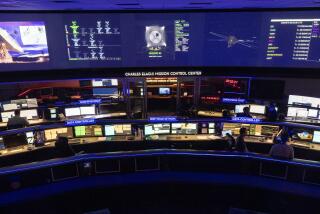Hubble Gyro Idled to Buy Some Time
- Share via
BALTIMORE — In a gambit calculated to add eight months to the life of the Hubble Space Telescope, scientists have shut down one of the telescope’s gyroscopes.
The Hubble is now operating on two gyros, something its designers never imagined.
By idling the third gyro, engineers and astronomers hope to buy more time for shuttle astronauts to reach the observatory with new gyros, fresh batteries and new scientific instruments.
“We actually tested it in orbit, and it worked far better than any of us expected,” said Preston M. Burch, Hubble program manager at the Goddard Space Flight Center in Greenbelt, Md.
He said the strategy should extend the Hubble’s lifetime through mid-2008, adding nearly two years to its observations.
Early in 2004, Sean O’Keefe, NASA administrator at the time, canceled plans for a fifth and final manned service mission to the Hubble.
He cited safety concerns raised by the Columbia shuttle accident.
Without servicing, scientists said, failed gyros would probably shut down the observatory as early as 2006.
O’Keefe’s successor, Michael Griffin, said in April that he would favor a manned mission to the Hubble, but only after two post-Columbia shuttle flights had returned safely.
The shuttle Discovery completed the first post-accident mission safely last month. Recurring problems with insulation shed from the spacecraft’s external fuel tank during launch has delayed further flights at least until March. Damage to NASA’s Gulf Coast support and construction facilities from Hurricane Katrina could cause additional delays.
The Hubble usually requires three working gyros to sense its motion in each of three dimensions. They keep the telescope aimed steadily at its target during photographic exposures, and assist in moving from one observation to the next. Three other gyros serve as backups. Of the six now on board, two have failed. That left three working units, and one reserve.
After the Columbia accident, scientists discovered that other components of the Hubble’s guidance system -- including devices that use the Earth’s magnetic field, star maps and the light from distant targets to orient and point the telescope -- could be used to substitute for data from the third gyro.
In-flight tests proved the scientific results in two-gyro mode were indistinguishable from the Hubble’s output on three.
“There is a slight loss of observing efficiency,” Burch said. Observations also had to be reordered and planning became more complicated.
But it works.
“We’ve been operating that way all week long,” he said. “We’ve been doing [turns] and science operations, and it’s working great.”
More to Read
Sign up for Essential California
The most important California stories and recommendations in your inbox every morning.
You may occasionally receive promotional content from the Los Angeles Times.













